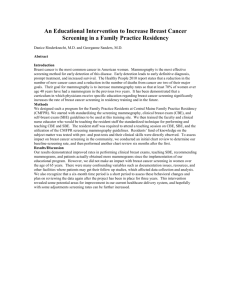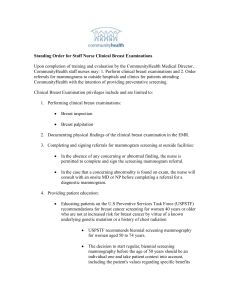The literature for this chapter was identified by a MEDLINE... English language review articles on breast cancer screening from 1992... 1. BREAST CANCER SCREENING
advertisement

1. BREAST CANCER SCREENING Deidre Gifford, MD, MPH The literature for this chapter was identified by a MEDLINE search for English language review articles on breast cancer screening from 1992 to the present, and by reviewing the U.S. Preventive Services Task Force Guide to Clinical Preventive Services (USPSTF, 1996). Once general topics for indicators were selected, additional articles reporting primary data on the topics were identified based on the bibliographies of the review articles and the USPSTF chapter and reviewed. In addition, a focused search for randomized trials of breast self-examination (BSE) was performed. IMPORTANCE Breast cancer is the most commonly diagnosed nondermatologic cancer and the second leading cause of cancer-related deaths among women in the United States (MMWR, 1996). In 1995, there were an estimated 182,000 newly diagnosed cases and 46,000 deaths from breast cancer in the U.S. (USPSTF, 1996). An estimated 12 percent of all U.S. women will be given the diagnosis during their lifetime, and 3.5 percent will die of this disease (Harris et al., 1992). Furthermore, the incidence of breast cancer is rising, with an increase of 55 percent between 1950 and 1991. For women, breast cancer is surpassed only by motor vehicle injury and infection as a cause for potential years of life lost before age 65 (USPSTF, 1996). SCREENING There are three principle methods available for breast cancer screening. These include periodic BSE, clinical breast examination (CBE), and screening mammography. The goal of all three methods is to detect breast cancer at an earlier stage than it would have been detected had the screening method not been used. Earlier detection of breast cancers is hypothesized to lead to higher detection of cancers before systemic involvement has occurred, leading to decreased mortality (Harris et al., 1992). There are limited data on the effectiveness of BSE in reducing mortality from breast cancer. One prospective non-randomized trial in the United 27 Kingdom compared breast cancer mortality in communities that received a BSE educational intervention with communities that did not (Ellman et al., 1993). There was no reduction in breast cancer mortality in the BSE communities at ten years of follow-up. The relative risk (RR) of death from breast cancer in the BSE groups was 1.01, with a 95 percent confidence interval (CI) of 0.86 to 1.17. Some retrospective studies have suggested that women who practice BSE present with earlier stage disease and less systemic involvement than those who do not, but other studies have found no effect (Baines, 1994). The additional benefit of BSE in populations already being screened with combinations of CBE and mammography is also not clear. The American Academy of Family Practice, American College of Obstetricians and Gynecologists (ACOG) and the American Cancer Society currently recommend teaching patients BSE, whereas the 1996 USPSTF report states that the evidence supporting the routine teaching of BSE is insufficient. Data about the effectiveness of CBE alone or in combination with mammography are inconclusive. Seven randomized trials have compared the effectiveness of mammography with or without CBE to no screening; no studies have directly compared annual CBE to no screening. The Health Insurance Plan of Greater New York trial compared annual mammography plus annual CBE with no screening in women aged 40 to 64 years at study entry (Shapiro et al., 1988). At 18 years of follow-up, there was a 20 percent reduction in breast cancer mortality in the screened group. Although the incremental benefit of CBE cannot be directly determined from this trial, modeling studies have suggested that two-thirds of the effectiveness may have been due to CBE (Eddy, 1989). In contrast to these findings of potential benefit to CBE, a meta-analysis of the seven mammography/CBE trials in women aged 40 to 79 reported similar reductions in breast cancer mortality between those screened with mammography alone (RR 0.78) and those screened with mammography plus CBE (RR 0.79) (Kerlikowske et al., 1995). The American Cancer Society, American College of Radiology, American Medical Association, and ACOG recommend annual CBE beginning at age 40. The USPSTF states that there is insufficient evidence to recommend for or against routine CBE in women aged 40 to 49, or on the use of screening CBE alone (without mammography). The effectiveness of screening mammography in women between the ages of 50 and 69 in reducing mortality from breast cancer has been documented by 28 several randomized trials (Kerlikowske et al., 1995; USPSTF, 1996). Mammography with or without CBE reduces mortality from breast cancer by 20 to 30 percent in this age group. established. The optimal screening interval has not been Although annual screening is recommended by many groups (USPSTF, 1996), the meta-analysis of seven randomized trials found equivalent mortality reductions in women screened every 12 months (RR 0.77) and women screened every 18 to 33 months (RR 0.77) (Kerlikowske et al., 1995). The USPSTF recommends routine screening with mammography alone or mammography and annual CBE in women aged 50 to 69 (Indicator 1). The effectiveness of routine mammography screening in women over age 69 has not been clearly established in randomized trials. None of the seven randomized clinical trials included women over age 74 at study entry. The Swedish two-county trial included women aged 70 to 74 and found no difference in the risk of breast cancer mortality between the group screened with mammography alone every 24 to 33 months and those not screened at all (RR 0.98; 95% CI 0.63-1.53, the wide confidence interval reflects the small number of women in this sub-group analysis) (Tabar, 1992). Among all subjects aged 40 to 74 at study entry, the two-county trial did show a significant reduction in breast cancer mortality. Breast cancer is prevalent in women over age 65, with 40 percent of cases occurring in this age group (Satariano, 1992). There is no evidence that mammography is less sensitive in this population, as there is in women under age 50 (USPSTF, 1996); however, with increasing age the added benefit of early diagnosis of breast cancer may be offset by competing morbidities, such that screening may be more beneficial in healthier older women than in those with many co-morbid conditions (Mor, 1992). The USPSTF guidelines state that although randomized trials have not yet shown a clear benefit of screening in this population, “recommendations for screening women aged 70 and over who have a reasonable life expectancy may be made based on other grounds, such as the high burden of suffering in this age group and the lack of evidence of differences in mammogram test characteristics in older women versus those age 50-69.” Organizations such as the American Cancer Society, American College of Radiology, American Medical Association, and ACOG do not specify an upper age limit for screening in their recommendations. Sub-group analyses of those randomized trials including women aged 40 to 49 at study entry do not clearly show a reduction in mortality in this age 29 group (RR 0.93; 95% CI 0.76-1.13). In the subgroup of women aged 40 to 49 at study entry who had two-view mammography and 10 to 12 years of follow-up, the mortality RR was 0.73 (95% CI 0.54-1.00) (Kerlikowske et al., 1995). This marginally significant finding suggests that the benefits of screening in women aged 40 to 49 may not be realized until longer follow-up times have been achieved; however, it is possible that the same result could be obtained if screening began at age 50. The USPSTF considers the evidence insufficient to recommend periodic mammography in women aged 40 to 49. 30 REFERENCES Baines CJ. 1994. The Canadian National Breast Screening Study: A Perspective on Criticisms. Archives of Internal Medicine 120: 326-34. Breast Cancer Incidence and Mortality - United States 1992. 1996. Morbidity and Mortality Weekly Report 45 (39): 833-51. Eddy DM. 1989. Screening for Breast Cancer. Archives of Internal Medicine 111: 389-99. Ellman R, Moss SM, Coleman D, and Chamberlain J. 1993. Breast self-examination programmes in the trial of early detection of breast cancer: ten-year findings. British Journal of Cancer 68: 208-12. Harris JR, Lippman ME, Veronesi U, and Willett W. 1992. Breast Cancer. New England Journal of Medicine 327 (5): 319-26. Kerlikowske K, Grady D, Rubin S, et al. 1995. Efficacy of Screening Mammography: A Meta-analysis. Journal of the American Medical Association 273 (2): 149-53. Mor V, Pacala JT, and Rakowski W. 1992. Mammography for Older Women: Who Uses, Who Benefits? Journal of Gerontology 47: 43-49. Satariano WA. 1992. Comorbidity and Functional Status in Older Women With Breast Cancer: Implications for Screening, Treatment, and Prognosis. Journal of Gerontology 47: 24-31. Shapiro S, Venet W, Strax P, et al. 1988. Periodic screening for breast cancer. Baltimore: Johns Hopkins University Press. Tabar L, Fagerberg G, Duffy S, et al. 1992. Update of the Swedish Two-County Program of Mammographic Screening For Breast Cancer. Radiologic Clinics of North America 30 (1): 187-92. US Preventative Services Task Force. 1996. Guide to Clinical Preventative Services, 2nd ed. Baltimore: Williams & Wilkins. 31 QUALITY INDICATORS FOR BREAST CANCER SCREENING The following indicators apply to women age 18 and over. 1. Indicator Women age 52 to 69 should have had a screening mammography performed in the past 2 years. Quality of Evidence I Literature Kerlikowske et al., 1995; USPSTF, 1996. Quality of Evidence Codes I RCT II-1 Nonrandomized controlled trials II-2 Cohort or case analysis II-3 Multiple time series III Opinions or descriptive studies 32 Benefits Reduce breast cancer mortality. Comments Meta-analysis of seven randomized trials shows that periodic screening mammography in this age group, with or without CBE , leads to a reduction in breast cancer mortality of 20-30%. Starting at age 52 ensures that the women eligible for this indicator have been over age 50 for at least 2 years.







